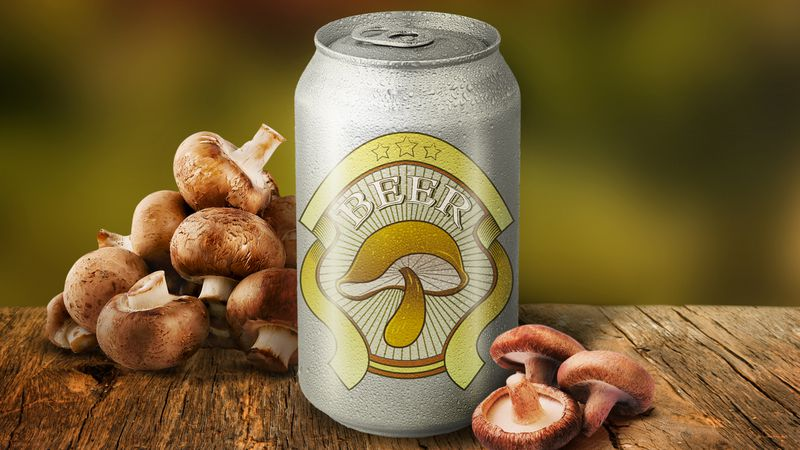What Is Mushroom Beer, And How (And Why) Do You Brew It?
We may receive a commission on purchases made from links.
In Acquired Tastes, The Takeout explores the food and drinks we can't live without.
Decorative Gourd Season is upon us, and the thoughtful beer drinker has a choice to make: follow the well-trod path and reach for a pumpkin ale, or take the path less traveled and seek out an unexpected fall-flavored beer made from mushrooms.
Yes, mushroom beers exist—around 100 on record at Untappd (a paltry number compared to the 12,412 pumpkin beers available). Though a tad off-putting in concept, in its ideal state, the mushroom beer hits with deep, rich, satisfying savory notes, as complex as the fungus that spawns it. That's what Hershey, Pennsylvania's Tröegs Independent Brewing Company was going for when it jump-started the current wave of mushroom beer in 2013.
"As a brewer, I'm constantly searching for umami," co-owner John Trogner said of Scratch Beer 119, an experimental mushroom porter made with help from the American Mushroom Institute. Although most mushroom beers are dark, like number 119, there are some that break that mold—such as Jester King Brewery's Snörkel out of Austin. Described as "Gose-inspired" with low alcohol and slight sourness, it picks up its smoky notes from alderwood-smoked sea salt. It then finds that sought-after umami thanks to a hefty dose of oyster mushrooms.
Some brewers have also turned to the mushroom's fancy cousin, the truffle. A few recent truffle beers have grabbed headlines, though mostly for their price tags. Chicago's Moody Tongue brewery sold 22-ounce bottles of Shaved Black Truffle Pilsner for $120 in 2014, while Tillamook, Oregon's De Garde Brewery made an American wild ale with white truffles earlier this year. It was limited to 400 bottles—some of which were offered for $200 on aftermarket websites. For the record, De Garde's truffle beer got better reviews than Moody Tongue's, though Moody did make the beer list at a number of high-end restaurants, including Thomas Keller's Per Se in New York City. One complaint leveled at Moody Tongue was that the truffle flavor wasn't discernible enough—and considering the only way truffles or mushrooms affect a beer is by flavor (alcohol level, mouthfeel, and viscosity don't change), it's understandable to want to taste where all that money went.
Of course, the role of mushrooms in beer wasn't always to add flavor. In The Brewer's Tale, William Bostwick describes an early form of beer made by Northern European shamans using mushrooms that may have induced delirium and "a deathlike sleep." In modern times, there are stories of "armchair shamans" mixing tea brewed from hallucinogenic mushrooms with beer, but being disappointed in results hewing closer to sleeplike sleep. You can get those effects with regular old beer, too—though even a shaman can't use a mushroom to make alcohol. For that you still need to rely on more traditional methods.
That simple fact could be why pumpkin beer holds such an outsize influence over American brewers. Brewers tend to use barley that has been malted—i.e., partially germinated to produce the right kinds of sugars for the yeast to eat and produce alcohol during fermentation. It's a process requiring specialized tools and skills and the right fruits and vegetables to yield those fermentable sugars. In the earliest American malt houses, colonists (including the nation's founding father of beer, Samuel Adams) used readily available, starchy gourds such as pumpkin and squash to brew their beer, back when—if cookbooks from that era are to be believed—brewing beer was as common a skill as baking bread. And that formative experience planted a deep-seated love of pumpkin beer in the American psyche, giving rise to the proliferation of pumpkin ales today.
For those whose seasonal tastes expand beyond liquid pie, mushroom beer provides an earthier alternative. As for how you make it, we turned to Michael Carroll, head brewer at Chicago's "culinary brewhouse" Band Of Bohemia, whose maitake mushroom beer caused a local stir when it debuted last year.

"Think of a good brown ale, and then you add a little bit of basmati rice," Carroll says. "You cook it and get a nice aromatic from the body, then toast it in the oven so it makes it kind of crunchy and adds another layer of depth of flavor to it." As for the mushrooms, Carroll puts them on a sheet tray and roasts them. "There's an aroma that comes from the flavor—from specifically maitake mushroom—that really goes well with a maltier, darker beer," he adds.
During the boiling step of brewing—after mashing the grains to extract sugars, and before pitching the yeast to start fermentation—Carroll will dip giant tea bags filled with roasted mushrooms and toasted rice in the wort. The mushrooms go in 20 minutes before the end of the boil, while the rice is there for only the final five minutes. The result, which Band Of Bohemia calls Maitake Basmati Nutty, is "just really dynamite," Carroll says. "It just kind of creates this layer of umami character that is rich and beautiful."
Sadly, Band Of Bohemia no longer makes this beer, but home-brew enthusiasts could approximate the effect by using a French press, steeping brown ale with roasted mushrooms and toasted rice for around five minutes. For those interested in trying their own mushroom beer, it could be a good application for your coffee brewer. After all, it's not like you're brewing coffee at home right now—it's pumpkin-spice latte season.
